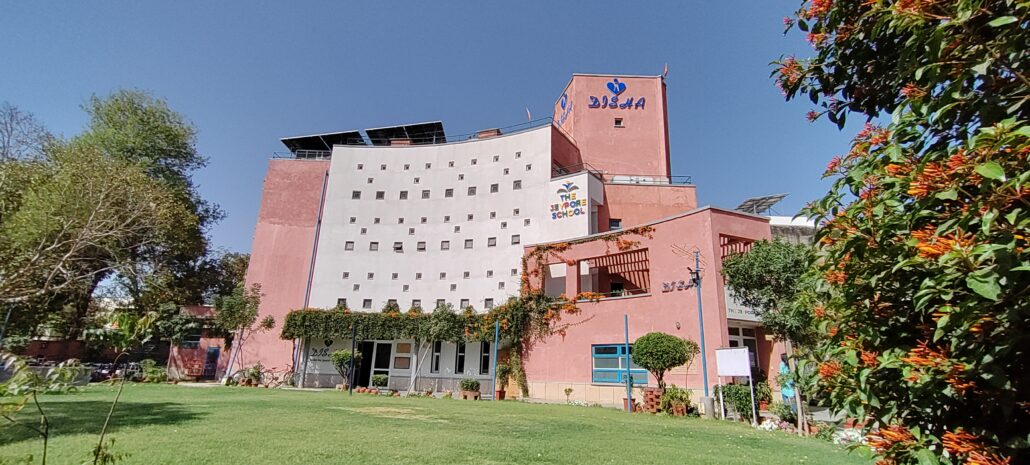The Jeypore School for Alternative Education is dedicated to providing a nurturing and supportive learning environment that prioritizes the holistic development of each student. By embracing alternative learning approaches, the school aims to empower students with essential life skills and foster their psychological, physical, cognitive, and social well-being.
Project Details
Project Stage : Completed in 2022
Built-Up Area : 34000 sqft
Developer : Disha Foundation
Address : T.N. Mishra Marg,Nirman Nagar-C, Jaipur – 302019, India
Satellite Location : 26.88864452, 75.75407923
Role : Resident Architectural Consultancy
The key focuses of the school:
- Smaller Classroom Setting:
- Recognizing the importance of personalized attention, the school maintains smaller classroom sizes to facilitate meaningful interactions between students and teachers. This allows educators to tailor their instruction according to individual learning styles and needs, ensuring that every student receives the support and guidance they require to thrive academically and personally.
- Individualized Training Programs:
- At the Jeypore School, each student benefits from an individualized training program tailored to their unique strengths, challenges, and interests. By customizing educational experiences, the school maximizes student engagement and achievement, fostering a sense of ownership and autonomy over their learning journey.
- Positive and Encouraging Environment:
- The school cultivates a positive and encouraging learning environment characterized by mutual respect, collaboration, and support. Students are encouraged to explore their interests, express their creativity, and take intellectual risks without fear of judgment or failure. Through positive reinforcement and constructive feedback, the school nurtures confidence, self-esteem, and a love for learning.
- Positive Behavior Management:
- Emphasizing proactive strategies for behavior management, the school promotes a culture of mutual respect, responsibility, and accountability. By focusing on positive reinforcement, conflict resolution, and restorative practices, educators empower students to make responsible choices, develop self-discipline, and cultivate healthy interpersonal relationships.
- Safe Environment for Every Student:
- Above all, the Jeypore School prioritizes the safety and well-being of its students, creating a secure and supportive environment where every individual feels valued, accepted, and protected. Through comprehensive safety protocols, trained staff members, and a commitment to inclusivity and diversity, the school fosters a sense of belonging and security that allows students to thrive both academically and emotionally.

School architecture designed to accommodate alternative learning approaches prioritizes flexibility, collaboration, and creativity to support diverse educational methodologies.

Here are some key features and considerations for designing The Jeypore School building:
- Flexible Learning Spaces:
- Alternative learning approaches often require adaptable environments that can be easily reconfigured to accommodate various teaching styles and activities. Flexible classrooms with movable furniture, modular partitions, and multipurpose areas allow educators to create dynamic learning environments tailored to different instructional needs.
- Collaborative Areas:
- To facilitate collaboration and group work, school architecture should include dedicated collaborative spaces such as project rooms, breakout areas, and shared learning commons. These zones encourage teamwork, peer interaction, and creative problem-solving, fostering a sense of community among students and teachers.
- Outdoor Learning Environments:
- Integrating outdoor spaces into the school design enables hands-on learning experiences and connection with nature. Outdoor classrooms, gardens, and recreational areas provide opportunities for experiential learning, exploration, and sensory engagement, promoting physical activity, well-being, and environmental stewardship.
- Technology Integration:
- Incorporating technology seamlessly into the learning environment is essential for supporting alternative learning approaches. School architecture should include infrastructure for digital connectivity, interactive displays, and multimedia presentations, allowing educators to integrate technology into instruction effectively.
- Personalized Learning Zones:
- Recognizing the importance of individualized instruction, school buildings should include designated spaces for personalized learning activities. These may include quiet zones for independent study, resource centers for research and inquiry-based learning, and reflection areas for self-directed exploration and reflection.
- Sensory-Friendly Design:
- Alternative learning approaches often cater to students with diverse sensory needs and learning styles. School architecture should incorporate sensory-friendly design elements such as natural lighting, acoustic treatments, and ergonomic furniture to create comfortable and inclusive learning environments for all students.
- Community Engagement Spaces:
- School buildings can serve as hubs for community engagement and lifelong learning by incorporating spaces for family involvement, community events, and partnerships with local organizations. Multipurpose auditoriums, exhibition areas, and community centers promote collaboration between schools and their surrounding communities, enriching the educational experience for students and residents alike.

The Jeypore School for Alternative Education embodies a student-centered approach to education that celebrates diversity, fosters resilience, and promotes lifelong learning. By embracing alternative learning methodologies and prioritizing the holistic development of each student, the school equips learners with the skills, knowledge, and confidence they need to navigate the complexities of the modern world and lead fulfilling lives.